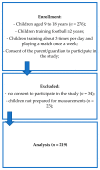The Diagnostic-Measurement Method-Resting Energy Expenditure Assessment of Polish Children Practicing Football
- PMID: 33670785
- PMCID: PMC7922541
- DOI: 10.3390/diagnostics11020340
The Diagnostic-Measurement Method-Resting Energy Expenditure Assessment of Polish Children Practicing Football
Abstract
Establishing the amount of energy needed to cover the energy demand of children doing sport training and thus ensuring they achieve an even energy balance requires the resting energy expenditure (REE) to be estimated. One of the methods that measures REE is the indirect calorimetry method, which may be influenced by many factors, including body composition, gender, age, height or blood pressure. The aim of the study was to assess the correlation between the resting energy expenditure of children regularly playing football and selected factors that influence the REE in this group. The study was conducted among 219 children aged 9 to 17 using a calorimeter, a device used to assess body composition by the electrical bioimpedance method by means of segment analyzer and a blood pressure monitor. The results of REE obtained by indirect calorimetry were compared with the results calculated using the ready-to-use formula, the Harris Benedict formula. The results showed a significant correlation of girls' resting energy expenditure with muscle mass and body height, while boys' resting energy expenditure was correlated with muscle mass and body water content. The value of the REE was significantly higher (p ≤ 0.001) than the value of the basal metabolic rate calculated by means of Harris Benedict formula. The obtained results can be a worthwhile suggestion for specialists dealing with energy demand planning in children, especially among those who are physically active to achieve optimal sporting successes ensuring proper functioning of their body.
Keywords: children and adolescents; indirect calorimetry; metabolism; physical activity; resting energy expenditure.
Conflict of interest statement
The authors declare no conflict of interest.
Figures
Similar articles
-
Longitudinal analysis of resting energy expenditure and body mass composition in physically active children and adolescents.BMC Pediatr. 2022 May 10;22(1):260. doi: 10.1186/s12887-022-03326-x. BMC Pediatr. 2022. PMID: 35538456 Free PMC article.
-
Resting Energy Expenditure of Physically Active Boys in Southeastern Poland-The Accuracy and Validity of Predictive Equations.Metabolites. 2020 Dec 1;10(12):493. doi: 10.3390/metabo10120493. Metabolites. 2020. PMID: 33271803 Free PMC article.
-
An evaluation of resting energy expenditure in hospitalized, severely underweight patients.Nutrition. 1999 May;15(5):384-8. doi: 10.1016/s0899-9007(99)00068-4. Nutrition. 1999. PMID: 10355852
-
Energy expenditure in hospitalized patients: implications for nutritional support.Mayo Clin Proc. 2006 Jun;81(6):809-16. doi: 10.4065/81.6.809. Mayo Clin Proc. 2006. PMID: 16770981 Review.
-
Estimation of Resting Energy Expenditure Using Predictive Equations in Critically Ill Children: Results of a Systematic Review.JPEN J Parenter Enteral Nutr. 2018 Aug;42(6):976-986. doi: 10.1002/jpen.1146. Epub 2018 Mar 30. JPEN J Parenter Enteral Nutr. 2018. PMID: 29603276
Cited by
-
Nutritional perspectives in female soccer: a scoping review.J Int Soc Sports Nutr. 2024 Dec;21(1):2366427. doi: 10.1080/15502783.2024.2366427. Epub 2024 Jul 3. J Int Soc Sports Nutr. 2024. PMID: 38961627 Free PMC article.
-
Longitudinal analysis of resting energy expenditure and body mass composition in physically active children and adolescents.BMC Pediatr. 2022 May 10;22(1):260. doi: 10.1186/s12887-022-03326-x. BMC Pediatr. 2022. PMID: 35538456 Free PMC article.
References
-
- Krauss H. Fizjologia żywienia człowieka. Physiology of Human Nutrition. 1st ed. PZWL; Warsaw, Poland: 2019. pp. 75–85.
-
- Chęcińska Z., Krauss H., Hajduk M., Białecka-Grabarz K. Ocena sposobu żywienia młodzieży wielkomiejskiej i obszarów wiejskich. Assessment of nutrition in urban and rural youth. Probl. Hig. Epidemiol. 2013;94:780–785.
LinkOut - more resources
Full Text Sources
Other Literature Sources



